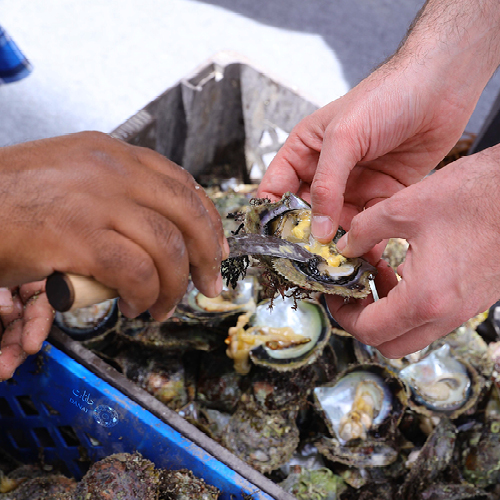For centuries, divers have risked their lives to hunt for natural pearls in the oyster beds around the islands of Bahrain. The rarest and most remarkable pearls can garner hundreds of thousands of dollars or more.
At the birth of the pearl trade, the adventurous divers, who leapt from boats with only rudimentary equipment, took serious risks. Some suffered blindness from eye infections they sustained in the salty sea, while others lost their hearing after descending or surfacing too quickly without equalizing the air pressure in their ears.
After a dive, these treasure hunters sat down to start the lengthy process of shucking their haul: opening the oyster with a specially crafted, blunt knife and then searching the flesh inside to try and find a pearl. It is very rare to find a natural pearl in a wild oyster, and most are cast aside when they fail
to yield one.
Natural pearls can come in all shapes, sizes, colors, and degrees of luster. Divers dream of finding a “Dana” pearl, an exceptional natural pearl that would command huge sums. The most revered in the marketplace tend to be perfectly round and white, while other pearls can show hues of pink, green, brown or yellow.
Merchants can spend decades gathering strings of natural pearls into a magnificent necklace, as the gems must be carefully matched and graduated to create a rare and beautiful piece of jewelry.
Intangible value
Natural pearls account for just 0.2% of the world’s pearl supply, according to the Bahrain Institute for Pearls and Gemstones (DANAT); the rest are cultured. As such, natural specimens carry a serious price premium.
“The value of natural pearls is in the intangible value, which is derived from their rarity,” says DANAT CEO Noora Jamsheer. “Cultured pearls replicate the appearance of a natural pearl, but do not compensate for the rarity. Both might have a similar physical appearance or chemical characteristics, but they differ greatly in intrinsic value — in their rarity.”
It is important that buyers of pearl jewelry be aware of the difference between natural and cultured pearls, and have confidence in what they are buying. To address this need, DANAT issues certifications for pearls and pearl jewelry at its laboratory. It also offers gemology courses in association with the Gemmological Association of Great Britain (Gem-A), as well as delivering world-leading research on pearls.
“As home to some of nature’s finest natural pearls, we have an obligation to uphold the highest standards of authenticity — as well as to preserve our natural heritage,” says Jamsheer.
A lustrous history
A century ago, natural pearls were the gems of the royal courts. Julius Caesar banned anyone but the ruling class from wearing them. Roman historian Pliny the Elder wrote about Bahrain and its abundance of natural pearls.
Originally, natural pearls were fished from various locations worldwide. However, the trade flourished in the Arabian Gulf, and Bahrain became the center of the natural pearl trade, according to Ottoman and British records. Pearls from around the Gulf were brought to Bahrain, where they were sorted and shipped to trading centers around the world. Jacques Cartier visited Bahrain in 1912 to source natural pearls directly for his jewelry maison.
Although there were many attempts to culture pearls throughout history, it was in the early 1900s that culturing methodologies developed and cultured pearls started entering markets. This caused concern among traders, and the Gulf governments banned the trade in cultured pearls because at the time, traders were unable to distinguish them from their natural counterparts. Bahrain issued a public notice in 1928 prohibiting anyone from selling, offering for sale, or possessing cultured pearls for trading. This is still enforced by law today.
When cultured pearls from Japan reached the market around the 1930s, the natural pearl business in Bahrain was hard hit, and revenues slumped. By 1972, Bahrain was the only country in the Gulf to continue the ban on cultured pearls, and it established a pearl-testing laboratory to ensure no cultured specimens entered the market.

Image: Bahrain Institute for Pearls and Gemstones (DANAT)
Reviving the sector
Several years ago, Bahrain’s government launched the National Plan to Revive the Pearl Sector. This aimed to strengthen the country’s status as a global center for natural pearls. Natural pearl beds and other pearl sites around Bahrain have since been declared UNESCO World Heritage Sites, and Bahrain is the only country in the world that regulates pearl diving for tourists.
The plan had five objectives: protecting the pearl beds, adopting systems to ensure their sustainability, reviving the historical significance of Bahrain’s natural pearl trade, modernizing that trade, and establishing the Bahrain Institute for Pearls and Gemstones (DANAT) as an innovative new testing lab for natural pearls.
Natural pearls remain integral to Bahrain’s economy and culture. About 7 kilograms of natural pearls are fished from Bahraini waters every year, and the kingdom is taking proactive steps to protect its marine environment and safeguard future supply.
Main image: DANAT on natural pearls. (DANAT)



